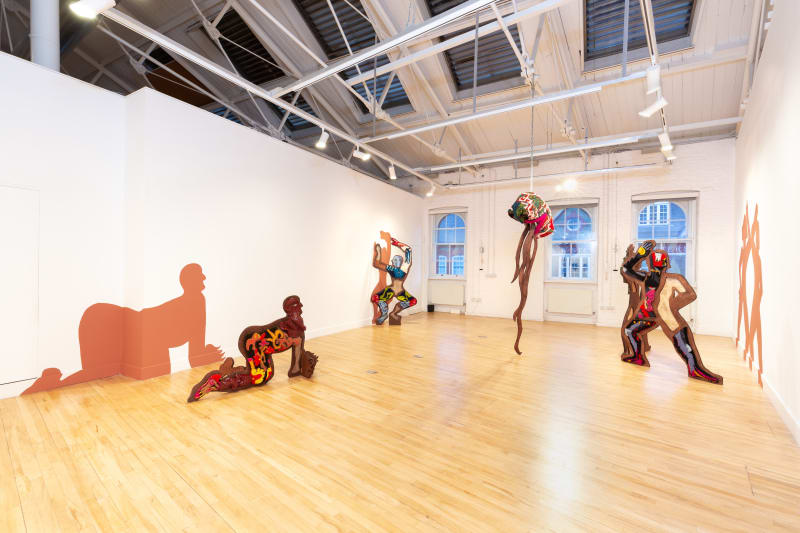Anna Perach and Anousha Payne have collaborated to create an immersive installation in which their contrasting aesthetic practices are united by the shared themes and concepts that permeate their work. In As She Laughs the gallery is populated by four large sculptures which dominate the space, three figurative works and a giant head which hangs suspended by chains in the center of the gallery. On the walls are painted the distorted and elongated shadows cast by the sculptures. Hinting at firelight, ritual and magic the shadows unite the artworks, a sculptural coven of female forms.
Using the surrealist concept of the "exquisite corpse" as a point of departure the sculptures combine Perach and Payne's work. The term was coined in the first half of the twentieth century, the result of the collective automatic writing employed by the surrealists. An initial writing experiment resulted in the following sentence "The exquisite corpse shall drink the new wine." The audacity and originality of this sentence is reflected in the shockingly new aesthetic of Payne and Perach's hybrid sculptures. Perach uses 'tufting' to create carpets that are then fashioned into three-dimensional sculptures while Payne is largely known for her exquisitely rendered ceramics. Wood and rattan frames provide figurative folding screens off which the artists have hung their tufted and ceramic body parts. Often used in domestic furniture the rattan provides the perfect domiciliary foil to the traditionally domestic mediums they both employ.
Myth and folklore act as the inspiration behind both artistic practises. Together Payne and Perach mine multiple sources including Greek mythology, Southern Indian folklore and Iranian short stories to create their sculptures; all of which represent female protagonists undergoing transformation. The limbs of the freestanding sculptures can be detached from the rattan, the figures are therefore only partially formed, the rest of their body parts can be seen hung on the wall. There will be a second act in which the sculptures undress, their limbs scattered across the gallery walls.
These are sculptures without a comfortable resolution. The fractured body parts echo the fractured narratives from which they emerge; they have been captured in the moment of transformation. A ceramic head has empty sockets for eyes, one of which has slipped towards the back of the head, inviting the viewer to both read into them the blank stare of the Greek statue and the maternal witchery of 'eyes in the back of your head'. In the tufted central sculpture Perach has created an intricate pattern which references troy-town mazes, echoing the labyrinthine stories from which their new 'characters' emerge.
If the wooden frames of the other sculptures are the skeleton upon which the bodies are hung then the hanging central head is essentially spewing forth the very fibre from which they are all made. The head acts as a centrifugal force within the space, from its mouth emerges a torrent of flamelike wooden branches and staccato vocal sounds, a soundscape influenced by Konnakol singing (a vocal tradition resembling scat singing within Southern Indian music). Informed in part by the myth of Daphne, who persecuted by Apollo transforms into a laurel tree, the sculpture is, again, caught in the act of metamorphosis. The wooden fronds that emerge from the mouth are an expression of the inadvertent spilling of one's true feelings, a Freudian slip rendered concrete in wood. This is no classical, effeminate Daphne but rather a raw and magical rendering of a women continually forced to transform. Both a power and a weakness, this mutability maps the subjugated but powerful role of women historically. Payne and Perach have created a new mythology through which we can reflect upon our own reality.


